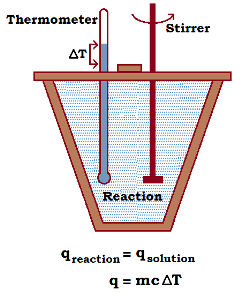When two bodies (one being solid and other liquid or both being liquid) at different temperatures are mixed, heat will be transferred from body at higher temperature to a body at lower temperature till both acquire same temperature. The body at higher temperature releases heat while body at lower temperature absorbs it, so that
Heat lost = Heat gained
i.e. principle of calorimeter represents the law of conservation of heat energy. (1) Temperature of mixture (T) is always ≥ lower temperature (TL) and ≤ higher temperature (TH), i.e.
(1) Temperature of mixture (T) is always ≥ lower temperature (TL) and ≤ higher temperature (TH), i.e.
TL ≤ T ≤ TH
i.e., the temperature of mixture can never be lesser than lower temperatures (as a body cannot be cooled below the temperature of cooling body) and greater than higher temperature (as a body cannot be heated above the temperature of heating body). Furthermore usually rise in temperature of one body is not equal to the fall in temperature of the other body though heat gained by one body is equal to the heat lost by the other.
(2) When temperature of a body changes, the body releases heat if its temperature falls and absorbs heat when its temperature rises. The heat released or absorbed by a body of mass m is given by, Q = mc DT
Where c is specific heat of the body and DT change in its temperature in oC or K.
(3) When state of a body changes, change of state takes place at constant temperature [m.pt. or b.pt.] and heat released or absorbed is given by, Q = mL
Where L is latent heat. Heat is absorbed if solid converts into liquid (at m.pt.) or liquid converts into vapours (at b.pt.) and is released if liquid converts into solid or vapours converts into liquid.
(4) If two bodies A and B of masses m1 and m2, at temperatures T1 and T2 (T1 > T2) and having gram specific heat c1 and c2 when they are placed in contact.
Heat lost by A = Heat gained by B
Or
m1c1 (T1 – T) = m2c2 (T – T2) [Where T = Temperature of equilibrium]
∴ \(T=\frac{{{m}_{1}}{{c}_{1}}{{T}_{1}}+{{m}_{2}}{{c}_{2}}{{T}_{2}}}{{{m}_{1}}{{c}_{1}}+{{m}_{2}}{{c}_{2}}}\)
- If bodies are of same material c1 = c2 then \(T=\frac{{{m}_{1}}{{T}_{1}}+{{m}_{2}}{{T}_{2}}}{{{m}_{1}}+{{m}_{2}}}\)
- If bodies are of same mass (m1 = m2) then \(T=\frac{{{T}_{1}}{{c}_{1}}+{{T}_{2}}{{c}_{2}}}{{{c}_{1}}+{{c}_{2}}}\)
- If bodies are of same material and of equal masses (m1 = m2, c1 = c2) then \(T=\frac{{{T}_{1}}+{{T}_{2}}}{2}\)
